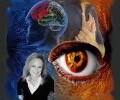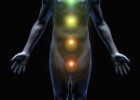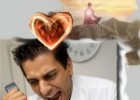Spontaneity and the Creative Process- Part II
In the previous blog entry titled, “Spontaneity and the Creative Process- Part I”, I discussed how spontaneity functions only in the present moment, a time period I refer to as the creative moment.
The creative moment is when time intersects with the unknown, vastness of consciousness, and the endless possibilities the creative individual can draw upon.
An image from the Voyager Archetypal card deck, created by Dr. James Wanless, accurately depicts this creative moment. In the image, there is the manifested, physical world symbolized by the abundance of images toward the front of the card. In the center of the card, there is the Buddha standing at a portal to the unmanifested, unseen world. I see this card symbolizing the key to creative abundance, and that key is the stillness of mind, represented by the Buddha.
Spontaneity is the readiness to act from stillness of mind and creativity is the action itself. The former occurs before the creative moment and the later occurs after. To explore why creativity becomes thwarted or blocked, an examination of what can occur in the creative moment is warranted.
Factors Influencing the Creative Moment
First, there are the different types of possibilities the person has available to draw upon. For example, if a person wants to run a marathon and has not worked a running program, then the probability of drawing upon a possibility of winning a marathon is slim to none. But, if an athlete trains, focuses and develops his or her body for marathon running, then a possibility of winning or finishing the marathon becomes more probable. The practiced runner is developing mastery.
Also, in regards to the marathon runner, if the person has developed processes around determination, discipline and commitment, to name a few, then, these attributes not only increase the athletes probabilities of completing the race but, these qualities become easily available for other creative endeavors.
The act of engaging an aspect of the creative endeavor is an important factor in increasing the probability of reaching your creative goals.
Another factor that influences the creative moment is fear. Fear negatively effects spontaneity, and it is the only factor that changes its nature resulting in negative outcomes. Fear chokes off our readiness to act in the moment, and we respond out of reactivity to situations from past wounded patterns. We do not create new responses, opportunities or innovative ideas to current problems.
For example, a product sales engineer wants to bid on a large project, and to ensure closing the deal, he needs to have an innovative design to under-bid his competition. The sales engineer is unaware that he has an internal conflict with women expressing anger. A woman who expresses anger reminds him of his critical mother, and he loses confidence in his own level of intelligence and completing tasks. As the engineer takes his new innovation into his manager’s office, he is confronted with her anger at his bottom line estimate. The engineer loses his confidence, and along with it, his ability to present his ideas to his boss. The engineer leaves her office in defeat.
His defeat builds on itself, and he has now reinforced his wounded pattern, which will make it more difficult to overcome and enact new possibilities in the future. When we are aware of our patterns, then we are able to take steps to release those limiting beliefs that prevent us from being fully present in the moment, open to new possibilities and new creative ways to manifest in our world.
Part III, will look at how to move beyond those fears and free up the mind to engage the creative moment.



